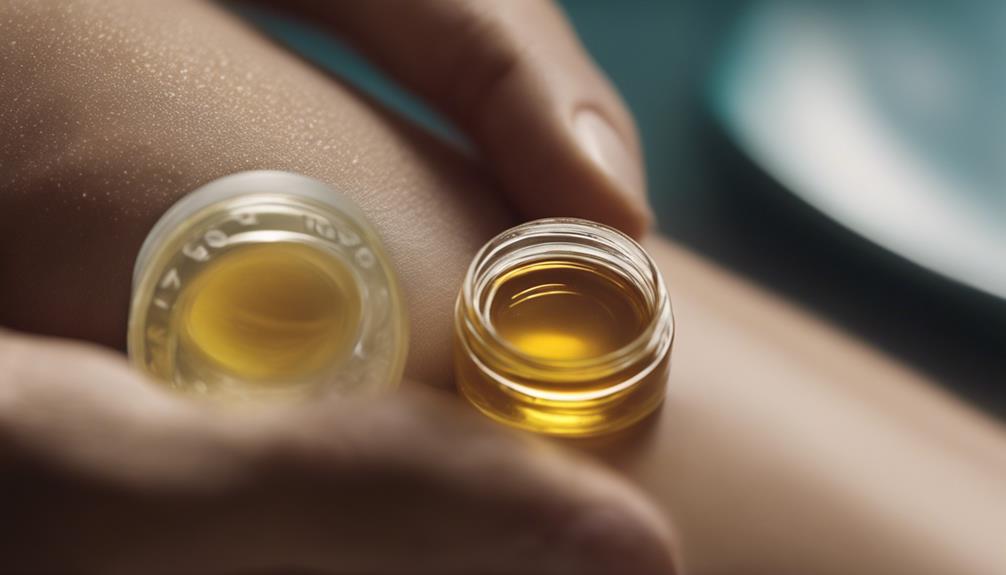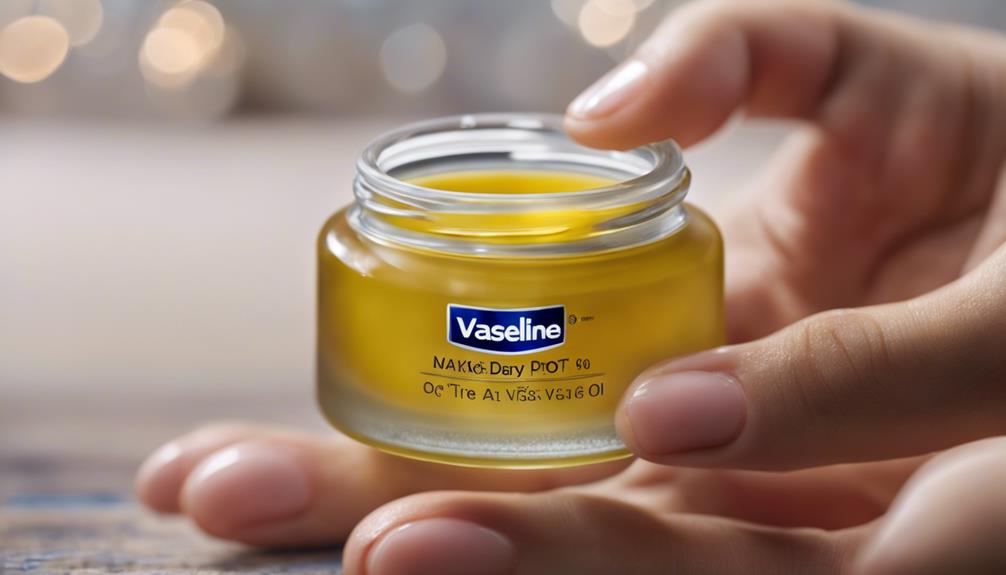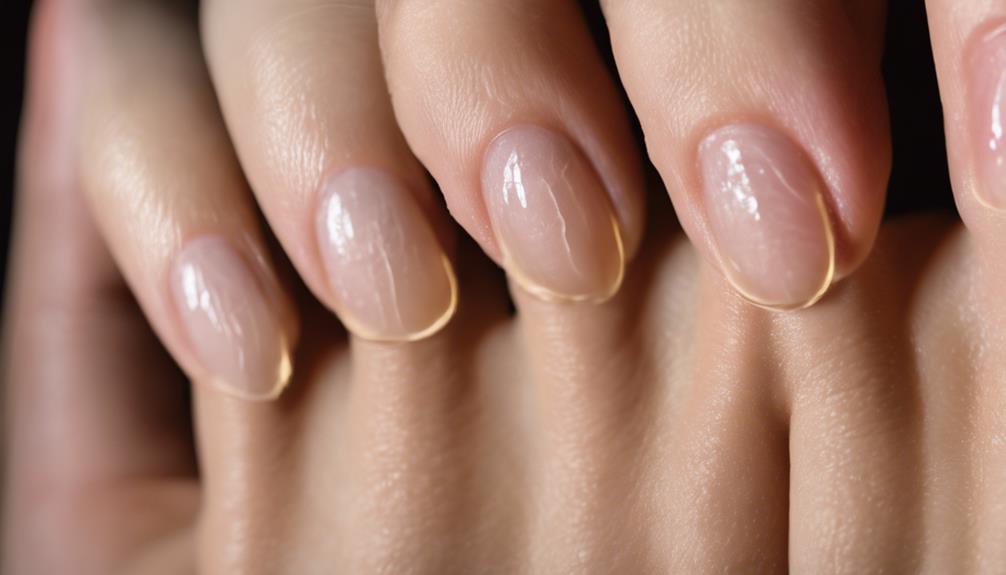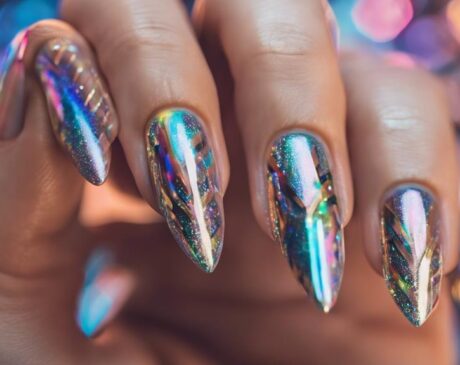Can I Use Vaseline Instead of Cuticle Oil?

While Vaseline can offer some moisturizing benefits, cuticle oil is more effective for promoting healthy nail growth and nourished cuticles. Cuticle oil contains essential nutrients like jojoba, almond, or vitamin E oils, which are specifically designed to strengthen and protect cuticles. Vaseline primarily acts as a barrier to lock in moisture, but it may not provide the same enriching benefits as cuticle oil. For optimal nail care and overall nail health, utilizing cuticle oil is recommended. Further information on the specifics of Vaseline and cuticle oil benefits can be discovered in the detailed research provided.
Key Takeaways
- Vaseline can be used as an alternative to cuticle oil for basic moisture and protection.
- However, Vaseline lacks the enriching nutrients and specialized benefits of cuticle oil.
- Cuticle oil is more effective in nourishing and strengthening the nails and surrounding skin.
- Vaseline may leave a greasy residue and not absorb as well as cuticle oil.
- For optimal nail health and care, cuticle oil is recommended over Vaseline.
Differences Between Vaseline and Cuticle Oil

Cuticle oil and Vaseline differ significantly in their composition and intended use within nail care routines. Cuticle oil is specifically formulated to nourish and moisturize the delicate skin around the nails, promoting healthy growth and preventing dryness and cracking. It is typically made from a blend of natural oils such as jojoba, almond, or vitamin E oil, all known for their hydrating and strengthening properties.
On the other hand, Vaseline, also known as petroleum jelly, is a semi-solid mixture derived from petroleum. While Vaseline can provide some level of moisture to the cuticles, its primary function is to create a barrier on the skin to lock in moisture. This makes Vaseline more suitable for protecting the skin from external elements rather than actively nourishing and promoting nail health.
When choosing between cuticle oil and Vaseline, it is essential to consider your specific nail care needs. If you are looking to strengthen and hydrate your cuticles, cuticle oil would be the preferred choice due to its targeted formulation. However, if you simply need a protective barrier, Vaseline can serve that purpose effectively.
Benefits of Using Cuticle Oil
Nourishing the delicate skin around the nails with a specialized oil can bring a range of benefits to your overall nail health. Cuticle oil is formulated to moisturize, strengthen, and protect the cuticles, promoting healthy nail growth and preventing issues such as hangnails and dry, cracked skin. By regularly applying cuticle oil, you provide essential nutrients like vitamins and minerals to the nail bed, aiding in the maintenance of strong, flexible nails that are less prone to breakage. Additionally, cuticle oil helps improve the overall appearance of your nails by keeping them hydrated and enhancing their natural shine. This specialized oil also plays a crucial role in preventing fungal infections and other nail diseases by maintaining the skin's barrier function and promoting a healthy nail environment. By incorporating cuticle oil into your nail care routine, you not only support the health and appearance of your nails but also indulge in a relaxing self-care practice that nurtures both your nails and your well-being.
Benefits of Using Vaseline

Vaseline offers excellent moisturizing properties that can help keep your cuticles hydrated and healthy. Additionally, it acts as a protective barrier, shielding your cuticles from external factors that may cause dryness or damage. Its affordability and versatility make it a convenient option for maintaining nail health and promoting strong, nourished cuticles.
Moisturizing Properties of Vaseline
With its exceptional emollient properties, Vaseline stands out as a reliable choice for providing deep hydration to the skin. This versatile product helps lock in moisture, making it an effective solution for dry and cracked skin, including cuticles. The occlusive nature of Vaseline creates a protective barrier on the skin, preventing moisture loss and promoting healing. Additionally, Vaseline is non-comedogenic, meaning it won't clog pores, making it suitable for sensitive skin types. Its simplicity and affordability make it a popular choice for moisturizing various areas of the body, including the cuticles.
| Moisturizing Properties of Vaseline |
|---|
| Locks in Moisture |
| Creates a Protective Barrier |
| Non-comedogenic |
Protection for Cuticles
A proven method for safeguarding cuticles and promoting their health involves utilizing the protective properties of a well-known emollient product. Vaseline, with its rich emollient benefits, forms a protective barrier on the cuticles, shielding them from external aggressors such as harsh weather conditions, chemicals, and frequent hand washing. This barrier helps lock in moisture, preventing dryness and cracking, which are common issues that can lead to painful hangnails and cuticle damage. By applying Vaseline regularly to your cuticles, you not only protect them from harm but also support their overall health and appearance. This simple yet effective practice can contribute significantly to maintaining soft, healthy cuticles that frame your nails beautifully.
Effectiveness of Vaseline on Cuticles
When comparing Vaseline to traditional cuticle oils, it is essential to consider the effectiveness of each product in nourishing and hydrating the cuticles. While Vaseline is a thicker, occlusive product that can lock in moisture, cuticle oils are often formulated with specific nutrients to target nail health. Understanding the benefits of cuticle oil, such as natural ingredients like vitamin E or jojoba oil, can help users make an informed decision on which product best suits their needs.
Vaseline Vs Cuticle Oil
Comparing Vaseline to traditional cuticle oils reveals the surprising effectiveness of this common household product in nourishing and protecting cuticles. While cuticle oils are specifically formulated to target the delicate skin around the nails, Vaseline can also provide similar benefits. Vaseline acts as a barrier that helps lock in moisture, preventing dryness and promoting healthier cuticles. Its occlusive properties create a protective layer that seals in hydration, making it an affordable and easily accessible alternative to cuticle oil. However, it is important to note that cuticle oils often contain additional beneficial ingredients such as vitamins and antioxidants tailored for nail and cuticle health. When considering Vaseline vs cuticle oil, personal preference, budget, and specific nail care needs should all be taken into account.
Benefits of Cuticle Oil
In assessing the effectiveness of Vaseline on cuticles, it is essential to recognize the inherent benefits that traditional cuticle oils offer in promoting nail and cuticle health. Cuticle oil provides several advantages that aid in maintaining healthy nails and cuticles:
- Hydration: Cuticle oil helps to hydrate and moisturize the cuticles, preventing dryness and cracking.
- Nourishment: It delivers essential nutrients to the nail bed, promoting overall nail health.
- Strength: Regular use of cuticle oil can strengthen the nails, reducing brittleness and breakage.
- Protection: It forms a protective barrier that shields the nails and cuticles from environmental damage.
- Growth: By improving circulation and nourishment, cuticle oil can support healthy nail growth.
How to Use Vaseline on Cuticles

To effectively use Vaseline on cuticles, gently massage a small amount of the petroleum jelly into the cuticle area to help nourish and moisturize the skin. This simple application can work wonders in keeping your cuticles healthy and hydrated. Here is a quick guide on how to use Vaseline on your cuticles effectively:
| Steps to Use Vaseline on Cuticles | Benefits |
|---|---|
| Apply a small amount of Vaseline on each cuticle. | Helps to lock in moisture and prevent dryness. |
| Gently massage the Vaseline into the cuticle area. | Improves blood circulation and promotes nail growth. |
| Leave the Vaseline on overnight for best results. | Allows for deep hydration while you sleep. |
| Repeat this process regularly for well-nourished cuticles. | Maintains healthy and strong nails. |
Potential Drawbacks of Using Vaseline
While Vaseline can be beneficial for cuticle care, there are some potential drawbacks to consider when using it on your nails. Using Vaseline as a cuticle oil alternative may present the following drawbacks:
- Limited Absorption: Vaseline may not be as easily absorbed by the nails and cuticles compared to specialized cuticle oils.
- Greasy Residue: Vaseline tends to leave a greasy residue that can feel heavy on the nails and surrounding skin.
- Potential for Clogged Pores: Due to its occlusive nature, Vaseline may clog the pores around the nails, leading to breakouts or irritation.
- Lack of Nutrients: Unlike cuticle oils that are enriched with vitamins and nutrients, Vaseline may not provide the same level of nourishment.
- Longer Healing Time: In some cases, using Vaseline may prolong the healing process of damaged cuticles compared to using cuticle oil.
Considering these potential drawbacks, it's essential to weigh the pros and cons before deciding to use Vaseline as a substitute for cuticle oil.
Conclusion: Vaseline Vs. Cuticle Oil

When comparing Vaseline to cuticle oil for nail care, the differences in nourishing properties and absorption rates become evident. Cuticle oil is specifically formulated to provide essential nutrients like vitamins and oils that promote healthy nail growth and moisturize the cuticles. These ingredients are easily absorbed into the skin, ensuring that the nails and surrounding areas receive the necessary hydration and nourishment. In contrast, while Vaseline can help lock in moisture, it lacks the specialized nutrients found in cuticle oil.
Cuticle oil is designed to penetrate the nail bed and cuticles efficiently, delivering targeted benefits that Vaseline may not provide. The lightweight nature of cuticle oil allows for quick absorption without leaving a greasy residue, making it a preferred choice for many individuals seeking optimal nail care. Ultimately, while Vaseline can offer some level of moisturization, cuticle oil remains a superior option for those looking to promote overall nail health and maintain well-nourished cuticles.
Frequently Asked Questions
Can Vaseline Be Used as a Substitute for Cuticle Oil?
While Vaseline can provide some level of moisture to the cuticles, it may not offer the same nourishing benefits as cuticle oil. Cuticle oil is specifically formulated to hydrate, strengthen, and protect the delicate skin around the nails.
Will Vaseline Provide the Same Nourishment as Cuticle Oil?
While Vaseline can provide some moisture and protection to cuticles, it may not offer the same nourishment as cuticle oil. Cuticle oil contains specific nutrients and oils designed to hydrate, strengthen, and promote healthy nail growth.
Is Vaseline a Cost-Effective Alternative to Cuticle Oil?
Vaseline may serve as a cost-effective option for cuticle care. However, while it can provide some moisture and protection, it lacks the specific nourishing properties found in cuticle oils designed to promote healthier nails and cuticles.
Can Vaseline Help Strengthen and Protect Cuticles Like Cuticle Oil?
Vaseline provides a protective barrier that can help strengthen and shield cuticles. While not a direct replacement for cuticle oil, it can offer some benefits in maintaining cuticle health. For optimal results, consider using both products.
Are There Any Specific Precautions to Consider When Using Vaseline on Cuticles?
When using Vaseline on cuticles, ensure the skin is clean and dry to prevent trapping bacteria. Apply a thin layer and avoid excessive rubbing to prevent damage. Exercise caution if prone to skin sensitivities or allergies.




